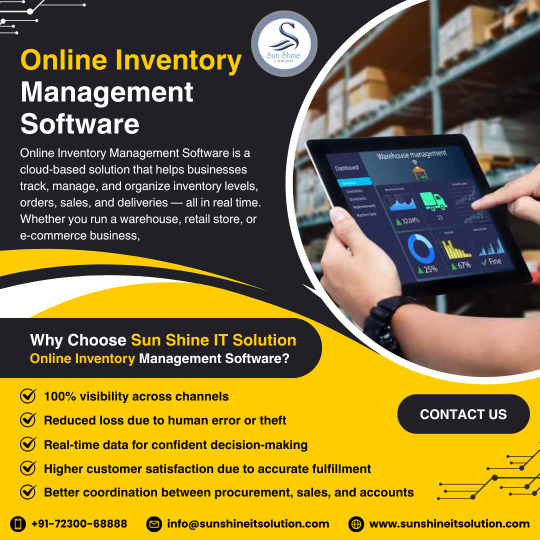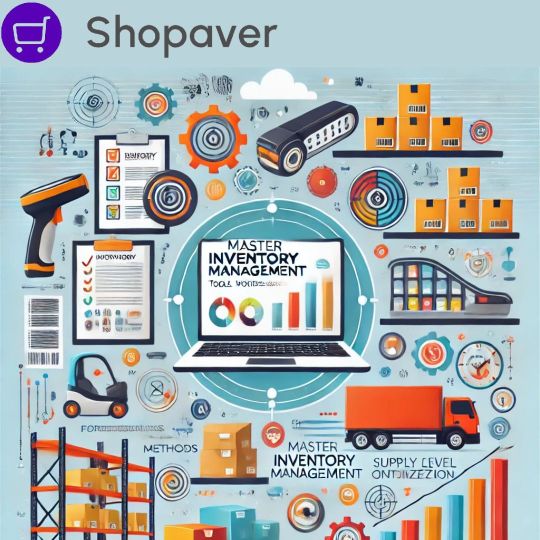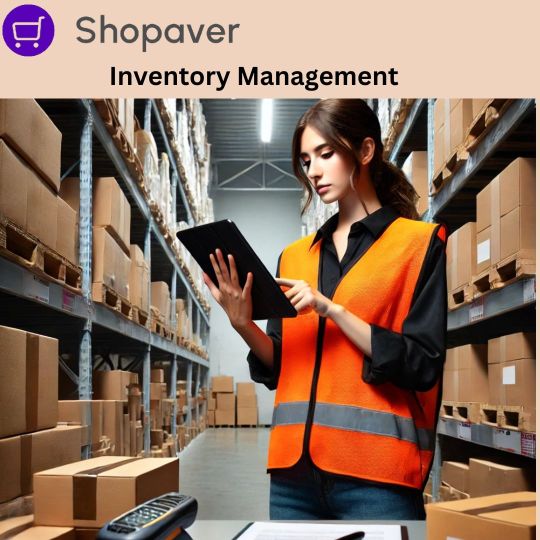#Inventorysoftware
Explore tagged Tumblr posts
Text
What is inventory allocation & how to allocate inventory efficiently? Here we can check out the strategies for an effective inventory allocation.
#inventory#inventoryallocation#inventorymanagement#inventorysoftware#inventoryallocationmethods#gcc#tranquilbs
2 notes
·
View notes
Video
tumblr
Store & Inventory Management Software Fully Integrated with other Department Call Us Now: 090091 55444, 9131333485 Visit: http://techwaveitsolutions.com/ http://concorderp.com/ . . .
#storemanagement#storemanagementsoftware#BusinessGrowth#inventorymanagementsoftware#softwarecompany#softwaredevelopmentcompany#instagramgrowth#StoreSoftware#InventorySoftware#reelsinstagram#trendingreels#reels#instagramstory#instagramstories#contentcreation#explore#viral#trending#viralreels#erpsoftware '#`software#development#erpservices#management#services#techwaveitsolutions#post#postoftheday#instagram#instagood
2 notes
·
View notes
Text
Future Growth Opportunities in the Global Inventory Management Software Market
In a world increasingly driven by digital transformation, the inventory management software market stands as a prime example of how businesses are leveraging technology to streamline operations and boost efficiency. From small e-commerce startups to global manufacturing giants, organizations across industries are adopting inventory management solutions to maintain control over their supply chains, minimize costs, and improve customer satisfaction.
As of 2025, the inventory management software market is experiencing substantial growth, driven by a combination of factors including globalization, the rise of omnichannel retail, advancements in automation, and the increasing importance of data-driven decision-making. According to industry research, the global inventory management software market is expected to surpass USD 5 billion by the end of the decade, with a compound annual growth rate (CAGR) exceeding 10%.

Driving Forces Behind Market Growth
1. E-Commerce Expansion
The explosive growth of e-commerce has fundamentally changed the way companies manage inventory. Online retailers must balance the challenges of maintaining optimal stock levels, avoiding overstock and stockouts, and meeting rapid delivery expectations. This has created an urgent need for robust inventory management tools that provide real-time tracking, automated replenishment, and integration with sales platforms like Shopify, Amazon, and WooCommerce.
2. Supply Chain Complexity
Today’s supply chains are more intricate than ever, often spanning multiple countries and involving numerous suppliers, warehouses, and transportation providers. Inventory management software helps businesses maintain visibility across these complex networks. Features such as demand forecasting, multi-location inventory tracking, and supplier performance analytics are becoming standard in modern solutions.
3. Rise of Cloud-Based Solutions
The shift from on-premise systems to cloud-based inventory management software has made powerful tools accessible to businesses of all sizes. Cloud platforms offer scalability, lower upfront costs, and the flexibility to integrate with other enterprise systems such as Enterprise Resource Planning (ERP) and Customer Relationship Management (CRM). Additionally, cloud-based tools support remote access, which is particularly valuable in today’s hybrid work environments.
Key Trends Shaping the Market
1. Integration with IoT and AI
Technologies such as the Internet of Things (IoT) and Artificial Intelligence (AI) are playing a growing role in inventory management. IoT devices like smart shelves and RFID tags enable real-time data collection, while AI-driven analytics can forecast demand, detect anomalies, and automate replenishment decisions. This combination helps businesses reduce waste, avoid costly errors, and improve decision-making accuracy.
2. Sustainability and Waste Reduction
As environmental concerns become more prominent, inventory management software is being designed with sustainability in mind. Features that help minimize overstocking, reduce expired or obsolete inventory, and support circular economy practices are gaining traction. Companies are also using software to track carbon footprints and optimize transportation routes for lower emissions.
3. Customization and Industry-Specific Solutions
Vendors are increasingly offering industry-specific inventory management solutions tailored to sectors like healthcare, food and beverage, automotive, and fashion. These customized systems consider unique regulatory requirements, seasonal demand variations, and specialized storage conditions, offering greater value than one-size-fits-all solutions.
Challenges and Considerations
Despite its rapid growth, the inventory management software market faces challenges. Data security and privacy remain top concerns, especially for businesses handling sensitive customer or supplier information. Integration with legacy systems can also be complex, requiring time and resources. Additionally, while automation reduces manual errors, it also requires ongoing employee training and change management to ensure successful adoption.
The Road Ahead
The inventory management software market is poised for continued expansion as businesses seek greater agility and resilience in their operations. With ongoing technological advancements and a growing focus on efficiency, the next wave of innovation will likely involve deeper AI integration, autonomous supply chains, and even more seamless connectivity across platforms.
For companies navigating an increasingly volatile global economy, investing in modern inventory management software is no longer a luxury it's a necessity. As the market matures, those who adopt early, innovate boldly, and leverage data intelligently will be best positioned to thrive.
0 notes
Text

🚀 Streamline Your Stock. Simplify Your Success.
Say goodbye to manual spreadsheets and stock mismanagement! 📦✨ Our Online Inventory Management Software is designed to help businesses track, organize, and control their inventory in real-time — from anywhere!
Whether you're running a retail store, warehouse, or online business — our cloud-based solution gives you full visibility and control over your inventory.
📈 Boost productivity 📉 Minimize stockouts & overstocking 🧠 Make smarter business decisions
Please explore our YouTube channel for informative videos. Link :- https://www.youtube.com/@sunshineitsolutions
Visit our blog for informative business ideas https://www.blog.sunshiene.com/
Contact Us :- https://wa.me/+91-7230068888
WhatsApp Channel ( Subscribe for more updates ) https://whatsapp.com/channel/0029Vb0QMGg0bIdggODhE22T
#InventoryManagement#BusinessGrowth#InventorySoftware#CloudSoftware#RetailTech#WarehouseSolutions#SunShineITSolution
0 notes
Text
✅ 7 Essential Features of Inventory Management Software
Managing stock and warehouse operations can be a real challenge, especially for small businesses. That’s where Inventory Management Software comes in! 🚀 This tool helps businesses track, manage, and organize inventory in real time.
Whether you're running a retail store, eCommerce business, or warehouse, having the best inventory management system is a must.

1.Real-Time Inventory Tracking
One of the most important features of any inventory management system is real-time tracking. This lets you know what’s in stock, what’s running low, and what needs restocking. 📦
This is especially useful in warehouse management software to avoid overstock or stockouts.
2️⃣ Barcode Scanning & Automation
📲 Automation speeds up operations. With barcode scanning, you can update your inventory system quickly and accurately.
This is a must-have feature in any warehouse management software to improve efficiency and reduce errors.
3. Stock Alerts & Notifications
Never run out of products again! Set alerts for low stock and get notifications to reorder. ⏰ This feature is perfect for small business inventory management and helps keep your shelves full.
4. Multi-Location Management
If you store products in different warehouses, your warehouse management system should support multi-location tracking. 🗺️ This helps in managing inventory across multiple stores or warehouses with ease.
5️⃣ Easy Integration with Other Tools
Your inventory software should work well with other tools like accounting or sales platforms. 💼 Seamless integration saves time and makes inventory management more effective.
6. Reporting & Analytics
📊 A good stock management software provides insights into sales trends, product performance, and inventory levels. These reports help you make smarter business decisions.
7. User-Friendly Interface
Lastly, the inventory software for small business should be easy to use. A simple dashboard, clean layout, and helpful features make it easier for your team to manage stock effectively using the Inventory Management Software.
🎯 Conclusion
Choosing the best inventory management software is key to running a successful business.
From tracking stock to managing multiple locations, the right tool simplifies your inventory management process.
Make sure your inventory management system includes all these features to grow your business.
0 notes
Text
Building Inventory Software? Don’t Wing It. Do It Right. 🧠💻
Too many businesses start fast and fail faster when it comes to inventory management systems. Whether you're a startup or scaling enterprise — how you build your inventory software can make or break your operations.
✅ Streamline workflows ✅ Eliminate stockouts ✅ Reduce overhead ✅ Improve real-time decision making
Inventory can either be your biggest strength or your biggest headache. If your stock is scattered, your data is outdated, or your systems don’t talk to each other — you’re bleeding efficiency (and probably money 💸).
✨ Whether you're a growing startup, a manufacturer, or a retail business, custom inventory software can transform your operations — but only if it’s built the right way.
So, what does “right” even mean? ✅ Clear business objectives (no guesswork) ✅ Scalable architecture (grow without crashing) ✅ Real-time tracking & automation (goodbye manual errors) ✅ Seamless integrations (ERP, eCommerce, WMS — you name it) ✅ Intuitive UX (because your team deserves better than clunky interfaces)
In our latest blog, we break down: 🔧 Key features your system must have 📊 Tech stack recommendations 🧠 Best practices from real-world builds 🚫 Common mistakes that lead to costly failures
💡 Don’t just build software. Build a system that supports growth, minimizes risk, and creates competitive advantage.
📖 Read now: "Develop Inventory Management Software the Right Way"
#InventorySoftware#TechStrategy#DigitalTransformation#CustomSoftware#BusinessEfficiency#SaaSDevelopment#ProductivityTools#SupplyChainSolutions
1 note
·
View note
Text
Master Inventory Management: Tools, Methods & Best Practices
What Is Inventory Management?
Inventory management involves efficiently overseeing and controlling a company’s stock, including raw materials, work-in-progress goods, and finished products.
The process ensures that the right products are available in the right quantities at the right time to meet customer demand, avoiding both overstocking and understocking.

An Example of Inventory Management
Imagine a clothing retailer using inventory software for small business to manage stock. When new collections arrive, the system records the items' type and quantity. As sales occur, it updates stock levels in real-time, alerting the retailer when popular products are running low.
This proactive approach ensures timely restocking and prevents stockouts. Advanced inventory planning software can even forecast seasonal demand, helping businesses plan promotions effectively.
The Benefits of Inventory
Effective inventory management tools offer numerous advantages:
Improved Cash Flow
Businesses avoid over-purchasing and focus on products with consistent demand.
Enhanced Customer Satisfaction
Keeping popular items in stock ensures better customer experiences and loyalty.
Reduced Waste
Perishable goods are managed efficiently, minimizing spoilage and loss.
Efficient Space Utilization
Optimizing stock levels reduces storage requirements and costs.
Data-Driven Insights
Reporting tools provided by inventory management software for small business or a warehouse management system offer actionable analytics for smarter purchasing and production decisions.
Methods
Businesses use several methods based on their needs:
Just-In-Time (JIT): Reduces storage costs by ordering goods only as needed.
First-In, First-Out (FIFO): Ensures older inventory is used first, critical for perishable items.
Economic Order Quantity (EOQ): Balances ordering and holding costs to determine optimal order sizes.
ABC Analysis: Prioritizes stock management efforts based on value and sales frequency.
Four Types
Raw Materials Management: Tracks essential materials for production.
Work-In-Progress (WIP): Monitors items in the production phase.
Finished Goods: Ensures adequate stock of ready-to-sell products using stock management software.
MRO Inventory: Manages supplies not part of the final product, like tools and repair parts.
Red Flags
Watch for these common issues:
Frequent Stockouts: Lead to lost sales and customer dissatisfaction.
Overstocking: Increases storage costs and ties up capital.
Disorganized Stockrooms: Causes misplaced items and tracking errors.
High Shrinkage Rates: Indicates theft, damage, or management errors.
Summary
Effective inventory management is vital for businesses to maintain operational efficiency, reduce costs, and enhance customer satisfaction.
By using inventory software for small business, inventory planning software, or a warehouse management system, businesses can overcome challenges and transform operations into opportunities for growth. 🚀
#InventoryManagementSoftware#InventoryManagement#InventorySoftware#InventorySoftwareForSmallBusiness#BestInventoryManagementSoftware
0 notes
Text
How Do I Choose an Inventory Management System?
Choosing the right inventory management system (IMS) is crucial for optimizing your supply chain, improving accuracy, and boosting efficiency. Here are key steps and factors to consider when selecting an IMS:
Define Your Needs and Goals:
Identify specific challenges you want the IMS to address (e.g., stockouts, tracking errors, slow turnover).
Set clear objectives for the IMS, like improving inventory accuracy, reducing costs, or enhancing visibility.
Consider your company size, product types, and order volume to understand the level of functionality needed.
Look for Key Features:
Real-Time Tracking: Essential for accurate, up-to-the-minute visibility of inventory across multiple locations.
Order Management: Ensure it can handle orders from multiple channels, including e-commerce, wholesale, or retail.
Barcode/RFID Scanning: Automates data entry, reduces errors, and speeds up receiving, picking, and packing.
Reporting and Analytics: Look for advanced reporting capabilities to track inventory trends, sales performance, and forecasting.
Integrations: Ensure compatibility with your existing systems, such as accounting, ERP, CRM, or e-commerce platforms.
Assess Ease of Use and Scalability:
User-Friendly Interface: The system should be intuitive and easy to use, minimizing the need for extensive training.
Scalability: Choose a system that can grow with your business. It should easily adapt to increased order volumes, additional warehouse locations, or expanded product lines.
Consider Automation Capabilities:
The IMS should automate time-consuming tasks, like updating stock levels, sending reorder alerts, and generating purchase orders. Automation can help reduce manual errors and free up staff for higher-level tasks.
Check Cloud-Based vs. On-Premises Options:
Cloud-Based Systems: These offer remote access, regular updates, and typically lower upfront costs, which makes them ideal for growing or multi-location businesses.
On-Premises Systems: These may provide greater control and security for large businesses with dedicated IT resources, though they usually come with higher installation and maintenance costs.
Evaluate Cost and Budget:
Upfront vs. Subscription Costs: Consider whether a subscription-based or one-time payment model fits your budget better.
Total Cost of Ownership: Look at ongoing costs like maintenance, updates, support, and training. Don’t forget any hardware costs (e.g., barcode scanners, RFID devices).
Review Customer Support and Training Options:
A reliable support team is essential, especially during initial setup and as you scale. Check for availability of training materials, tutorials, and whether support is included or an added cost.
Look for Customization and Flexibility:
Choose an IMS that allows you to customize workflows, reports, and dashboards to align with your business’s unique needs. Some systems offer add-ons or modular features, letting you pay only for what you need.
Evaluate Vendor Reputation and Reviews:
Research reviews and case studies to understand how well the IMS has worked for similar companies. Customer feedback provides valuable insights into software performance, reliability, and user satisfaction.
Test the System with a Demo or Free Trial:
A hands-on trial helps you assess the system’s fit for your operations. Use this time to explore features, test ease of use, and verify that it aligns with your workflow.
By following these steps, you��ll be well-equipped to select an inventory management system that aligns with your business needs, supports growth, and ultimately improves efficiency in managing inventory.
Our Software Services:
Quotation Software | Sales Order Management Software | Purchase Order Management Software | Invoicing Software | Pick Pack Ship Software | Payment Processing Software
#quotation software#inventory software#inventorymanagementsystem#Inventory management system#inventorysoftware#bmobile route software#bmobileroutesoftware#united states#inventory management#inventorymanagementsoftware
0 notes
Text

Discover the power of Apeks Solutions' inventory management system software, designed to streamline your operations and enhance accuracy. Our software offers real-time tracking, comprehensive reporting, and seamless integration, ensuring your inventory is always optimized for peak performance.
#inventorymanagement#software#inventorysystem#businesssolutions#supplychain#inventorycontrol#inventorysoftware#logistics#warehousing#stockmanagement#businesssoftware#inventoryoptimization#supplychainmanagement#realtimetracking#inventoryefficiency
0 notes
Text
0 notes
Text

!!! 𝐇𝐔𝐑𝐑𝐘 𝐔𝐏 !!! 30% 𝑫𝒊𝒔𝒄𝒐𝒖𝒏𝒕 𝑶𝒇𝒇𝒆𝒓
Monteage
𝗖𝗮𝗹𝗹 𝗡𝗼𝘄 -9717096165
🍽️ Revolutionize your restaurant's backend with our powerful inventory management software! Say goodbye to guesswork and hello to streamlined operations. .
#Monteage#RestaurantInventory#inventorysoftware#KitchenSolutions#foodtech#Smartrestaurants#EfficiencyWins#restauranttech
0 notes
Text

Boost your business efficiency with Nammabilling's GST Accounting & Inventory Software. Streamline your operations and stay tax-compliant. #GST #Accounting #Inventory
#GSTAccounting#InventoryManagement#NammabillingSoftware#BusinessEfficiency#TaxCompliance#StreamlineOperations#AccountingSoftware#InventorySoftware#SmallBusinessTools#BusinessManagement#TaxManagement#BusinessSoftware#EfficientOperations#FinancialManagement#BusinessSolutions#GSTCompliance
0 notes
Text

BUSY's Inventory Accounting Software offers robust inventory management solutions, enhancing control and organization for businesses.
for more details visit site - https://busy.in/inventory-management-software/
0 notes
Text
0 notes
Text

🌟 Explore the world of auto retail with our Stock Inventory Software. 🚀 Discover how we're reshaping the industry one dealership at a time.
0 notes
Text
Effective Inventory Management: Optimize Operations and Reduce Costs 📦✨
Effective inventory management is essential for businesses striving to streamline operations and cut costs. It involves managing the flow of goods from suppliers 🛒 to warehouses 🏢, and eventually to the point of sale 🛍️.
Implementing the right stock management software can make this process seamless and efficient. 💻

Benefits of Inventory Software 🚀
1️⃣ Improved Efficiency ⚙️:
Stock control management tools automate tasks like stock tracking and reordering, saving time and reducing human errors ❌.
2️⃣ Cost Reduction 💸:
Inventory software for small businesses prevents overstocking 📈 or understocking 📉, minimizing storage costs and stockouts.
3️⃣ Better Customer Satisfaction 😊:
Real-time updates 🔄 allow businesses to meet customer demand promptly by maintaining optimal stock levels. ✅
Challenges in Stock Management Software ⚠️
Even with its benefits, stock management comes with its share of challenges:
⚡ Complexity of Tracking:
Managing diverse products 🛍️ across multiple locations 🌍 can be overwhelming without proper inventory planning software.
🌐 Supply Chain Disruptions:
External factors like vendor delays 🚚 or sudden demand spikes 📊 can lead to stockouts, creating challenges in fulfilling orders.
Strategies for Effective Inventory Management 🛠️
✅ Invest in the Right Tools:
Reliable stock control software helps businesses stay organized 📂, manage stock levels effectively 📋, and track product movements.
📊 Leverage Real-Time Data:
Stock management software provides real-time insights, helping prevent overstocking 🏢 or running out of stock 🔄.
📅 Plan for Seasonal Demand:
Businesses can use these tools to anticipate demand fluctuations 📈 and adjust stock levels, accordingly, ensuring smooth operations.
By adopting robust inventory software, small businesses can enhance their stock management processes, streamline operations, and boost profitability 📈.
FAQs ❓
What is inventory software, and why is it important?
Inventory software helps businesses track and manage their stock, from procurement to sales. It automates processes 🔧, improves accuracy ✔️, reduces human error ❌, and optimizes stock levels.
How does stock control software help reduce costs?
By maintaining optimal stock levels 🔄, this software prevents overstocking or understocking.
Can inventory management tools improve customer satisfaction?
Absolutely! ✅ These tools provide real-time tracking and updates 🔔, ensuring product availability 🛒 and timely deliveries 🚚. This results in happier, more satisfied customers 😊.
#InventoryManagementSoftware#InventoryManagement#InventorySoftware#InventorySoftwareForSmallBusiness#BestInventoryManagementSoftware
0 notes